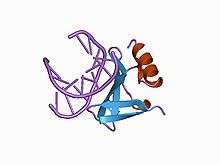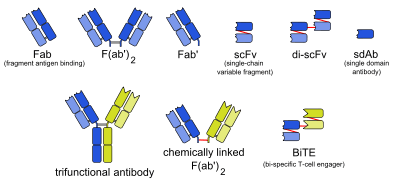Affitin
Affitins[1][2] (commercial name Nanofitins) are artificial proteins with the ability to selectively bind antigens. They are structurally derived from the DNA binding protein Sac7d, found in Sulfolobus acidocaldarius, a microorganism belonging to the archaeal domain. By randomizing the amino acids on the binding surface of Sac7d and subjecting the resulting protein library to rounds of ribosome display, the affinity can be directed towards various targets, such as peptides, proteins, viruses, and bacteria.[3][4] Affitins are antibody mimetics and are being developed as an alternative to antibodies as tools in biotechnology. They have also been used as specific inhibitors for various enzymes. Affitins can be utilized in biochemical purification techniques, specifically in affinity chromatography. The ability of Affitins to selectively bind antigens is used to target specific proteins. Scientists have been able purify human immunoglobulin G (hIgG), bacterial PulD protein, and chicken egg lysozyme using Affitin columns with a high degree of purity.[5] These have the ability to act as specific ligands for the proteins of interest that are needed when the fusion of proteins to polypeptide tags is impossible or carries no advantage, and thus build affinity columns as is in the case of the production of biopharmaceuticals. They were immobilized on an agarose matrix and the columns had a high degree of selectivity. In addition to this, antibodies and non-immunoglobin proteins can be purified by using affitins via affinity chromatography.[6] Due to their small size and high solubility, they can be easily produced in large amounts using bacterial expression systems.
Properties
Affitins consist of 66 amino acids and have a molecular mass of about 7 kDa, small compared to antibodies with some 130–150 kDa. Being obtained from a thermophile organism, they are unusually heat resistant proteins. In addition, Affitins are durable – they are able to withstand many cycles of purification. Unlike antibodies, affitins are produced in vitro, and therefore can be generated more quickly.[3] Due to their small size and high solubility, they can be easily produced in large amounts using bacterial expression systems.
Affitins are strongly modified reagents that are extremophilic since they are found in Archae like Sac7d, which is a hyperthermostable protein. They are artificially binding proteins with high affinity, small size, and low structural complexity. They have two different modes of binding. One requires just a flat surface whereas the second mode of binding requires a flat surface and two short loops. They are thermally and chemically stable reagents and their stability can be further increased by using mutation or grafting techniques. Other methods of stabilizing them include the use of sequence elements from other proteins that belong to the same family, switching a binding surface, and thus, have longer binding capacities. This was done by grafting the binding surface of D1Sac7d onto Sso7d, which is more stable, and by introducing point mutations previously identified as stabilizing for WT Sso7d.[7]
To summarize, Affitins are ideal reagents for affinity chromatography because they are durable, highly selective, cost effective, resistant to extreme alkaline pH and chemically and thermally stable. They also play a significant role in biotechnological and clinical applications. Affitin use provides important and useful methods for in vivo and in vitro analysis of protein structure.
References
- Correa, A; Pacheco, S; Mechaly, A. E.; Obal, G; Béhar, G; Mouratou, B; Oppezzo, P; Alzari, P. M.; Pecorari, F (2014). "Potent and specific inhibition of glycosidases by small artificial binding proteins (affitins)". PLoS ONE. 9 (5): e97438. Bibcode:2014PLoSO...997438C. doi:10.1371/journal.pone.0097438. PMC 4019568. PMID 24823716.
- Pacheco, S; Béhar, G; Maillasson, M; Mouratou, B; Pecorari, F (2014). "Affinity transfer to the archaeal extremophilic Sac7d protein by insertion of a CDR" (PDF). Protein Engineering Design and Selection. 27 (10): 431–8. doi:10.1093/protein/gzu042. PMID 25301962.
- Mouratou, B; Schaeffer, F; Guilvout, I; Tello-Manigne, D; Pugsley, AP; Alzari, PM; Pecorari, F (2007). "Remodeling a DNA-binding protein as a specific in vivo inhibitor of bacterial secretin PulD". Proceedings of the National Academy of Sciences of the United States of America. 104 (46): 17983–8. Bibcode:2007PNAS..10417983M. doi:10.1073/pnas.0702963104. PMC 2084283. PMID 17984049.
- Krehenbrink, M; Chami, M; Guilvout, I; Alzari, PM; Pécorari, F; Pugsley, AP (2008). "Artificial binding proteins (Affitins) as probes for conformational changes in secretin PulD". Journal of Molecular Biology. 383 (5): 1058–68. doi:10.1016/j.jmb.2008.09.016. PMID 18822295.
- Béhar, Ghislaine; Renodon-Cornière, Axelle; Mouratou, Barbara; Pecorari, Frédéric (2016). "Affitins as robust tailored reagents for affinity chromatography purification of antibodies and non-immunoglobulin proteins". Journal of Chromatography A. 1441: 44–51. doi:10.1016/j.chroma.2016.02.068. PMID 26952369.
- Béhar, G., Renodon-Cornière, A., Mouratou, B., & Pecorari, F. (2016). Affitins as robust tailored reagents for affinity chromatography purification of antibodies and non-immunoglobulin proteins. Journal of Chromatography A, 1441, 44-51.
- Béhar, G., Pacheco, S., Maillasson, M., Mouratou, B., & Pecorari, F. (2014). Switching an anti-IgG binding site between archaeal extremophilic proteins results in Affitins with enhanced pH stability. Journal of Biotechnology, 192, 123-129.

